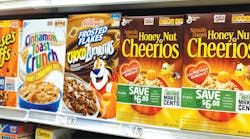When General Mills Inc. introduced a new product-loss elimination program in fiscal 2013, its aim was pretty simple: Add process, rigor and discipline to efforts that previously had been more hit-or-miss in nature.
What the Minneapolis-based food manufacturer discovered along the way is that looks can be deceiving.
The program in question is General Mills' Ingredient Overusage Reduction Program, which aims to find and eliminate losses that occur in the conversion of ingredients to finished products. For General Mills, finished products include everything from boxed cereals and yogurt to snack foods and baking products.
Rigor -- and detail -- is the name of the game. The program's 12 steps begin with pulling financial data associated with the losses and translating those dollar figures to pounds of product. That first step is key, says Richard King, global over-use program manager, because it sets the stage for clear communications: Production operators want to talk in pounds, not in dollars.
Equally important is identifying when and where the losses occur -- whether in steady state (when things are running well) or special cause state (when things aren't running so well) and in what precise location.
"When you're running well, you have a certain set of losses, and when you're not running well -- meaning you're broke down, you have a work process or equipment failure, you're in a changeover mode -- you have a different set of physical losses in your plant," King says. "Once you [identify] that, you're able to use a Pareto and say, 'OK, where are my major loss points and where do I want to spend my time.' You're going after the 20% of losses that cause 80% of your cost."
For General Mills, the site of its major losses was an eye-opener. "We saw that 70% to 80% of losses were in steady state," King says. In other words, a significant majority of losses were occurring when the plant seemingly was running well.
"When you think about losses, you think about when I break down or when I change over I see the pounds going into the bucket," King says. "Steady state losses tend not to be in the trash can. They tend to be things like extra going into the package to the customer."
That "extra" might be a fraction of a gram of product -- a piece of a Cheerio, perhaps -- but "multiply that by a billion packages and it gets to be quite significant."
With steady state losses, he notes, were a plant to ramp up productivity without addressing the reasons for the losses, "the better you run, the more you lose."
Of course, General Mills' overuse reduction program doesn't stop at identifying losses. Developing detailed action plans to address those losses, building future-state loss trees, providing regular progress reports and then redeploying the tool round out the process.
And it works. King says that every division in which the program has been introduced has observed a 20% decrease in over-use in its first year. General Mills reports that overall savings to date are approximately $10 million.
Even more, "90% of the solutions that came out of this are low or no capital," King says. They include process changes, such as performing some tasks on a daily basis rather than a monthly basis, or "scheduling through the lens of waste reduction."
"It makes a big difference," King says.





